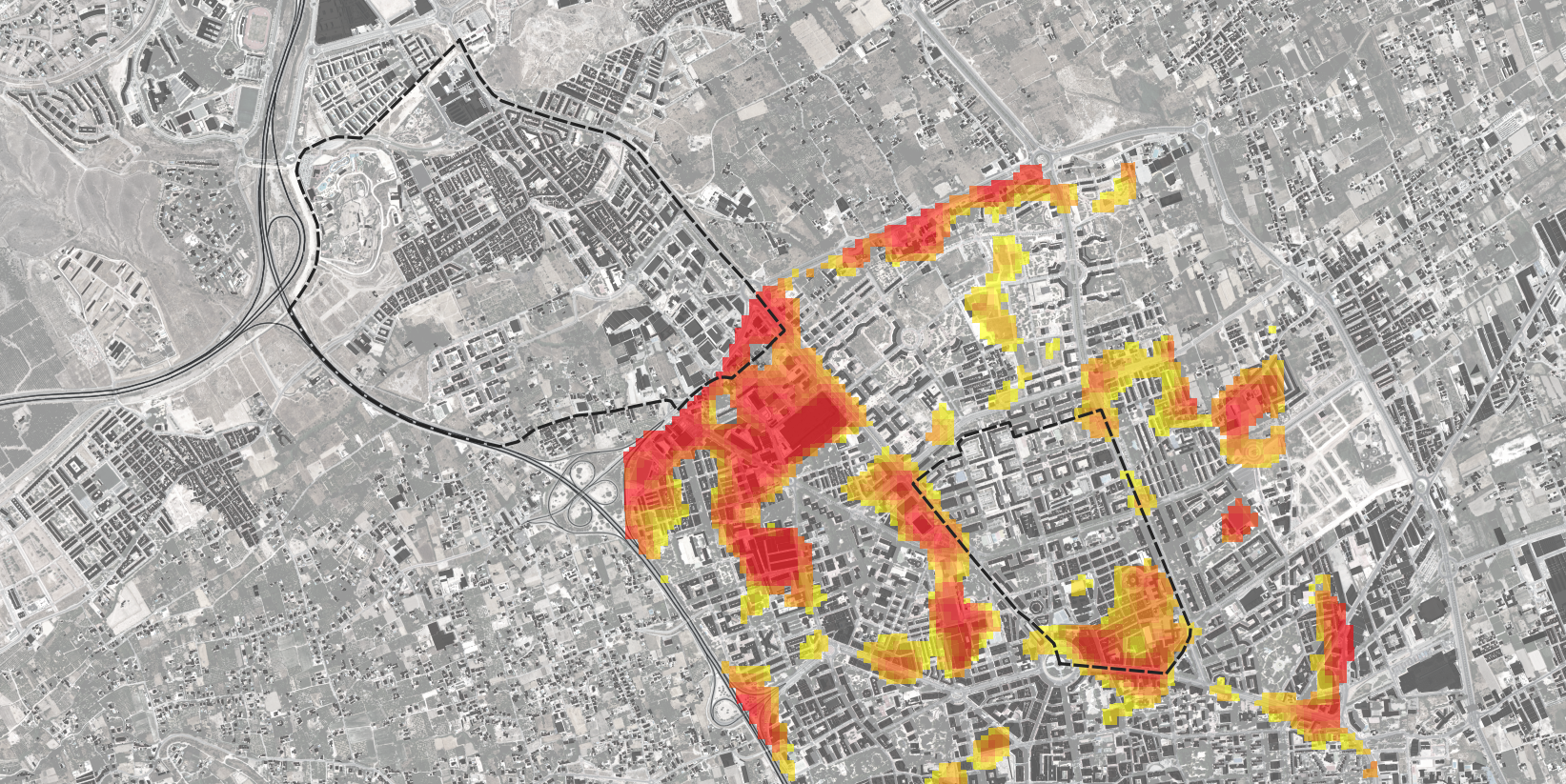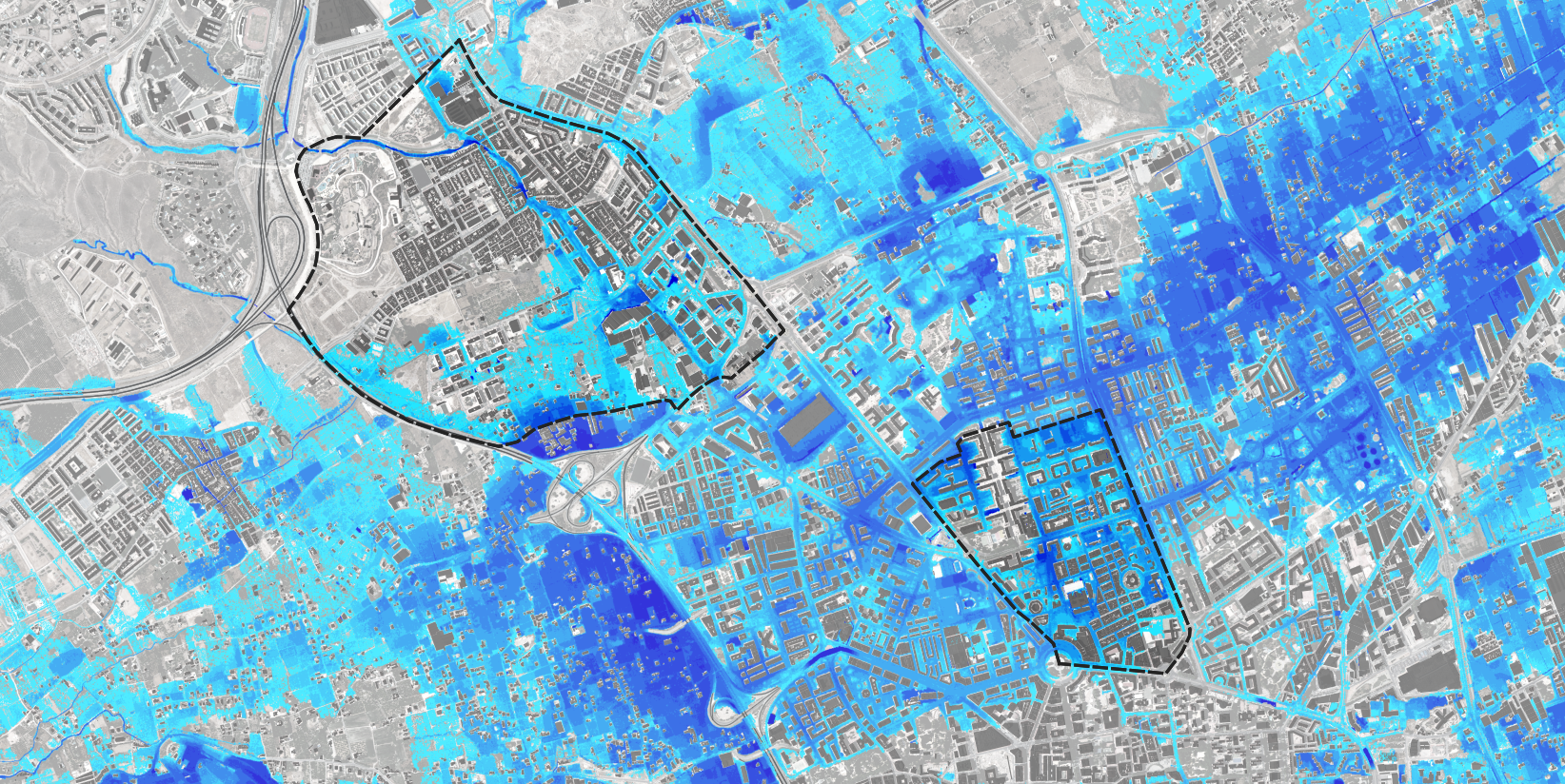Urban resilience to climate change: Challenges in Murcia's neighbourhoods
12 April 2024

Identifying the risks associated with climate change is crucial for planning the resilience of our habitats. The European Commission has classified these risks based on the sectors and thematic areas they would affect: water management during droughts and episodes of heavy precipitations; conservation of forests and forestry in fires, droughts, or landslides; the future of agriculture due to heat stress, disease outbreaks, or flooding; the resilience of urban environments to heatwaves and heavy precipitations; and the protection of coastal areas against rising sea levels, coastal erosion, and storms.

Figure 1. Key climate hazards to European sectors and thematic areas. Source, EEA, 2021.
Identifying areas affected by risks related to climate change
The effects of these risks are not uniform across the European Union, so a necessary first step in improving resilience to climate change is needed to assess the specific risks of each territory. For instance, if we focus on Murcia, an intermediate city with 450,000 inhabitants located in southeastern Spain, we can observe that its neighbourhoods are experiencing rising temperatures, changing precipitation patterns, and more frequent extreme weather events.
These challenges could vary even within the city. The Murcia FUTURESILIENCE lab will focus on two neighbourhoods. The Vista Alegre district in Murcia has a dense urban layout with limited green spaces, making it ideal for studying heat island resilience. In Espinardo, the presence of the Rambla de Algaramasa exacerbates flooding during rainfall, offering an opportunity to explore flood-related challenges. Moreover, the low intensity of amenities and connectivity difficulties with the city centre also make the role of compactness interesting in relation to climate change effects.
Impacts of climate change and possibilities for reduction
1. Reducing Urban Heat Islands impacts
Reducing the impacts of urban heat islands is crucial for enhancing the liveability and health of urban residents in Murcia. These heat islands not only diminish urban comfort but also pose health risks, particularly to vulnerable populations. Additionally, they contribute to increased energy consumption for cooling, exacerbating greenhouse gas emissions and straining energy infrastructure. Moreover, the uneven distribution of heat islands may exacerbate social inequalities, underscoring the importance of addressing social equity concerns.
Implementing Nature-Based Solutions (NBS) to enhance biodiversity in urban landscapes is imperative for mitigating heat island effects, improving overall urban comfort, and promoting social equity in Murcia's urban areas.

Figure 2. Urban Heat Island estimation in Murcia. Source: Rodríguez-Gómez, F., Fernández-Cañero, R., Pérez, G., del Campo-Ávila, J., López-Rodríguez, D., & Pérez-Urrestarazu, L. (2022).
2. Mitigating Flood Risks
The city of Murcia is dealing with significant challenges when it comes to managing heavy rainfall, often leading to flooding in streets and open areas.Besides damaging buildings and infrastructure, flooding also harms the environment by destroying habitats and polluting water sources. What's more, it puts lives at risk and widens social disparities.
To tackle these issues, we need comprehensive strategies. This includes improving sustainable drainage systems, using permeable surfaces, and integrating green infrastructure. But it's not just about infrastructure – community involvement is crucial too. By raising awareness about flood risks and empowering residents to get involved in flood management efforts, we can make a real difference.
And looking ahead, long-term planning is also a key. We must address underlying factors like land use planning and climate change adaptation to ensure a sustainable approach to flood management in Murcia's urban areas.
 Figure 3. Floodable areas with medium probability in Murcia. Source: Sistema Nacional de Cartografía de Zonas Inundables
Figure 3. Floodable areas with medium probability in Murcia. Source: Sistema Nacional de Cartografía de Zonas Inundables
3. Enhancing Urban Compactness
Murcia's urban sprawl worsens the effects of climate change, resulting in higher energy usage, longer commute times, and restricted access to essential services.
To tackle this challenge, we need to transition towards more compact urban development policies. This means reevaluating urban planning approaches to encourage mixed land-use development, denser urban areas, and the creation of reliable public transportation systems.
Planning actions to reduce the impacts of climate change
Looking at Murcia, it's clear that adaptation measures come in various forms, and putting them into actions will require substantial coordination and planning. However, deciding which actions to adopt presents its own set of challenges:
- Strategies: It's crucial to take a strategic approach, which includes planning for long-term urban model changes, implementing immediate interventions in the city, and managing risks during emergency events like heavy rainfall or heatwaves.
- Prioritization: Dealing with impacts sometimes requires many interventions across large areas, which can be costly. Therefore, it's crucial to prioritize actions and plan their implementation over time.
- Cross-disciplinarity: Implementing measures across various city management domains necessitates a holistic approach that involves integration among different technical specialists and taskforces.
- Synergies: It is important to remember that adapting to the effects of climate change involves transforming urban environments.
Thus, we must establish connections with other goals, such as creating healthier and more equitable cities. In this regard, over recent years, the city of Murcia has developed strategies for mitigating and adapting to climate change that encompass various actions across multiple strategic lines of action.
Planning resilience for climate change with foresight methods and science knowledge
The Murcia FUTURESILIENCE lab aims to focus on assessing climate and urban resilience using foresight methodologies. This will help identify vulnerabilities and key factors across various future scenarios. Enhancing the resilience of urban areas within the municipality of Murcia against climate change impacts requires a comprehensive approach. By tackling issues like urban heat islands, flood risks, and urban compactness, Murcia can strengthen its ability to adapt and create a more sustainable and resilient urban environment for residents. Collaboration among stakeholders is essential to implement effective strategies, ensuring the city's long-term viability in the face of climate change.
Integrating scientific knowledge to tackle climate change impacts in Murcia brings significant advantages but also presents challenges. Utilizing scientific insights enables a deeper understanding of climate-related risks and informs evidence-based decision-making, enhancing urban resilience. However, interpreting scientific data can be complex, and uncertainties in climate projections present obstacles to effective implementation. Moreover, while interdisciplinary collaboration is crucial, it can be difficult to achieve in practice.
Author: Fernando M. García Martín, UPCT, Spain.
Login to add a new comment